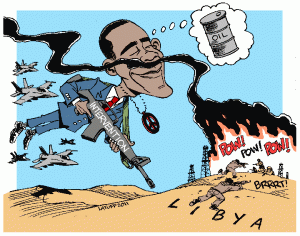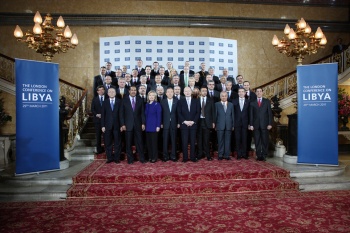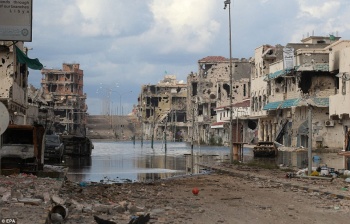2011 Attacks on Libya
| This page has been nominated for splitting up. As of October 2016, this page had 42 associated documents. Splitting it up would reduce this number. Use the discussion page to see the debate about this. |
 | |
| Date | 15 February 2011 - 23 October 2011 |
|---|---|
| Location | Libya |
| Perpetrators | Belgium, Bulgaria, Canada, Denmark, France, Greece, Italy, Netherlands, Norway, Romania, Spain, Turkey, United Kingdom, United States, Jordan, Qatar, Sweden, United Arab Emirates |
| Deaths | >60000">" can not be assigned to a declared number type with value 60000. |
| Interest of | 'Burning Blogger of Bedlam', Bernard-Henri Lévy |
| Description | A premeditated act of aggression that was carried out under a pretext of "humanitarian intervention". |
In 2011, 14 NATO members (Belgium, Bulgaria, Canada, Denmark, France, Greece, Italy, Netherlands, Norway, Romania, Spain, Turkey, United Kingdom & United States), and 4 other states (Jordan, Qatar, Sweden & United Arab Emirates) attacked Libya, beginning in March and ending on 31 October 2011, 10 days after Muammar Gaddafi was murdered by his NATO-backed rebel captors. Seven months of NATO airstrikes were estimated to have killed 60,000 Libyan civilians.[1]
Contents
Official Narrative
Many of the intervening countries talked about "humanitarian intervention". Wikipedia terms this event the "Libyan Civil War" and says nothing about foreign sponsorship.
Problems
The official narrative omits to note that in 2007, retired US 4-star General Wesley Clark told how he learned in 2001 of a Pentagon plan to destroy the governments of 7 countries in 5 years:- Iraq, Syria, Lebanon, Libya, Somalia, Sudan and Iran. [2].
Alternative Explanations
“Gaddafi's government holds 143 tons of gold, and a similar amount in silver. This gold was intended to establish a pan-African currency based on the Libyan golden Dinar. This plan was designed to provide Francophone Africa with an alternative to the CFA."”
Ellen Brown (14th March 2016) [3]
There is no shortage of alternative factors which may have contributed to the decision to attack Libya. These are summarised briefly below and elaborated on in the linked documents table.
Sovereign Wealth Funds
Before the US, Britain and France carried out a military attack on Libya to get their hands on its energy wealth, they took over the Libyan sovereign wealth funds, estimated at $70 billion. Facilitating this operation was the head of the Libyan Investment Authority (LIA), Mohamed Layas, as revealed in a cable published by WikiLeaks. On 20 January 2011, Layas informed the US ambassador in Tripoli that LIA had deposited $32 billion in US banks. Five weeks later, on February 28, the US Treasury "froze" these accounts. According to official statements, this is "the largest sum ever blocked in the United States," which Washington held "in trust for the future of Libya." Such an injection of capital will be welcome into the deeply indebted US economy. In March 2011, the EU "froze" around €45 billion of Libyan funds.[4]
Oil
Libya has the 9th largest reserves of oil, and the largest of any nation in Africa.
Gold Dinar
RT suggested that NATO intervention may have been motivated by Gaddafi's attempts to establish a unified federation of African states that would use the gold dinar as its currency and demand that foreign importers of African oil pay in gold.[5] Despite its stated opposition to NATO intervention, Russia abstained from voting on United Nations Security Council Resolution 1973 instead of exercising its veto power as a permanent member of the Security Council; four other powerful nations also abstained from the vote — India, China, Germany, and Brazil — but of that group only China has the same veto power. However, the fifth BRICS member, South Africa, actually voted in favour of UNSCR 1973.[6]
Financial Independence
With large supplies of oil, water, a relatively small population, a stockpile of gold and a leader in nobody's pocket, some have suggested that Libya was perceived as a country that was dangerously independent of Western influence. Ellen Brown notes that one of the first actions taken by the Libyan rebels was to set up their own central bank.[7].
Fresh Water reserves
A substantial area of the Nubian Aquifer lies beneath Libyan territory. It is the largest known fossil water aquifer containing an estimated 150,000 km3 of fresh water and is the source of the Great Man-made River, the world's largest irrigation project.[8]
Foreign Sponsorship
Evidence suggests that the war may have been incited, organised and/or funded by deep state actors outside the country. Ellen Brown asks why, although the rebels are still fighting, they have taken time out to create their own central bank.[9] A UK registered humanitarian charity, World for Libya, was revealed which operated in Libya with during that time, which has interesting links to another UK registered humanitarian charity in Syria at about the time a "humanitarian intervention" was planned for that country.
Related Quotation
| Page | Quote | Author | Date |
|---|---|---|---|
| Mario Borghezio | “Gaddafi was a great leader, a true revolutionary who should not be confused with the new Libyan leadership swept into power by NATO's bayonets and by oil multinationals” | Mario Borghezio | 2011 |
Related Documents
References
- ↑ "NATO airstrikes killed 60,000 Libyan civilians"
- ↑
- ↑ http://www.theecologist.org/News/news_analysis/2987399/why_qaddafi_had_to_go_african_gold_oil_and_the_challenge_to_monetary_imperialism.html The Ecologist
- ↑ "Financial Heist of the Century: Confiscating Libya’s Sovereign Wealth Funds (SWF)"
- ↑ "Saving the world economy from Gaddafi" RT, 5 May 2011. Retrieved 24 May 2012.
- ↑ "UN authorizes no-fly zone over Libya." Al Jazeera. 18 March 2011. Retrieved 24 May 2012.
- ↑
- Radio show about how the establishment lies by omission
- ↑ "Great Man-made River Project"
- ↑ http://www.unwelcomeguests.net/550

